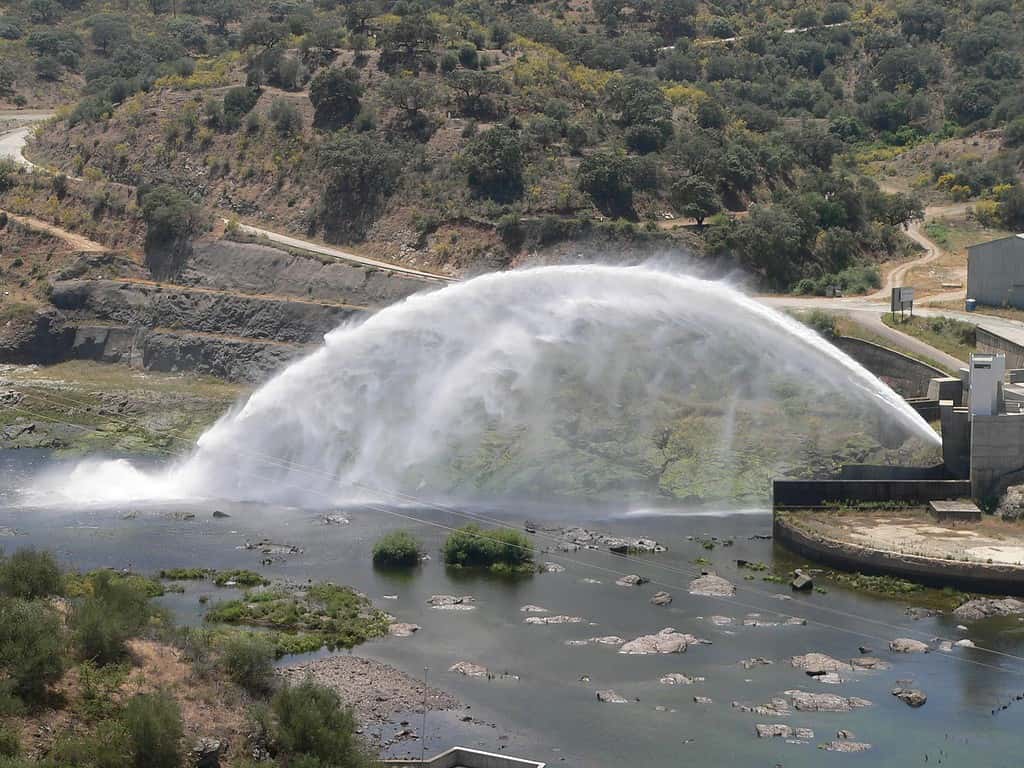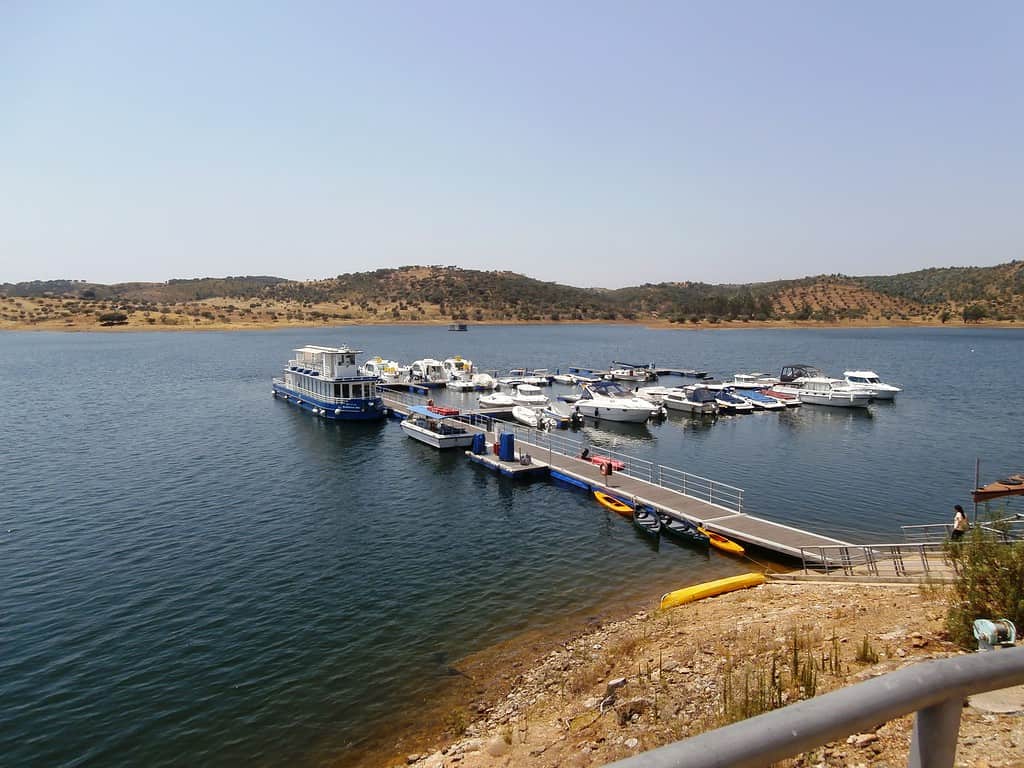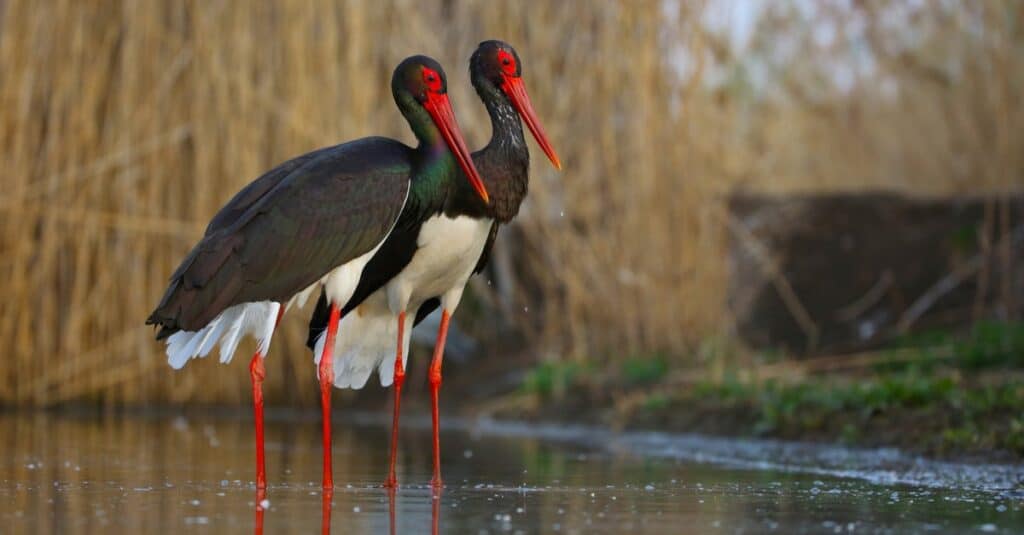Europe, a continent known for its rich history and diverse landscapes, also boasts some remarkable feats of human engineering — its man-made lakes. Here we’ll explore the largest man-made lake in Europe.
These bodies of water, varying dramatically in size from quaint ponds to sprawling reservoirs, serve a multitude of purposes. They provide precious water supplies, generate renewable energy, offer recreational havens, and even stimulate local economies. Moreover, each lake carries its own unique tale of human ambition and ingenuity.
The Largest Man-Made Lake in Europe
Alqueva Dam’s reservoir is Europe’s largest man-made lake. Nestled in the southern reaches of Portugal, the dam stands as a remarkable testament to human ingenuity. It’s a place where technological prowess meets natural beauty, creating a symbiosis that’s truly breathtaking.
Perched on the serene Guadiana River, the Alqueva Dam is at the heart of the Alentejo region, known for its sun-drenched landscapes and robust olive groves. The dam itself is an impressive structure. It stretches over 1,500 ft. in length and rises to a height of 315 ft.
And the water it holds back? That’s where things get even more impressive. The Alqueva Reservoir, formed by the dam, is the largest artificial lake in Europe, covering a massive area of around 62,000 acres. That’s enough water to fill more than 4 million Olympic swimming pools!
Background and History
Before diving into the details of the Alqueva Dam, let’s take a step back and understand its origins and the driving forces behind its construction.
Why the Alqueva Dam Was Built

The Alqueva Dam was built to address the region’s issues of water scarcity and economic underdevelopment.
©Ceinturion, CC BY-SA 4.0 – License
The Alqueva Dam was conceived as a solution to several pressing challenges faced by the Alentejo region of Portugal. The primary motivation for constructing the dam was to address the region’s long-standing issues of:
- Water scarcity
- Agricultural limitations
- Economic underdevelopment
By creating a vast reservoir and harnessing the power of hydroelectricity, the Alqueva Dam aimed to improve water management, boost agricultural productivity, generate clean energy, and stimulate regional economic growth.
- Drought management. The idea of the Alqueva Dam was born out of the need to tackle severe droughts in the region. Southern Portugal faced recurring water scarcity, which threatened agriculture and the livelihoods of local communities. Building the dam was seen as a solution to provide a reliable water supply and improve water management.
- Agricultural support. Agriculture plays a vital role in Portugal’s economy, and the Alqueva Dam was designed to bolster this industry. By providing a stable source of water for irrigation, the dam has enabled increased crop yields, diversification, and overall agricultural growth in the region.
- Economic development. The dam’s construction was also aimed at fostering economic development in the area. Through the generation of renewable energy and the creation of new job opportunities, the Alqueva Dam has helped boost the local economy and improve the living standards of the people in the region.
Timeline of the Dam’s Construction
The journey to building the Alqueva Dam was filled with milestones and challenges. However, the dam was finally completed after decades of planning and overcoming obstacles. This paved the way for a brighter future for the region.
- Key milestones. The concept of the Alqueva Dam first emerged in the 1950s. But it took several decades for the project to come to fruition. Construction officially began in 1995. After numerous delays, the dam was finally completed in 2002. The inauguration of the dam’s hydroelectric power station in 2004 marked the start of the dam’s role in Portugal’s renewable energy sector.
- Challenges faced during construction. Building the Alqueva Dam was no easy feat. The project faced several challenges, such as securing funding, navigating complex geological conditions, and addressing environmental concerns. Despite these obstacles, the dam’s construction ultimately prevailed.
How Was the Alqueva Dam Built?
Now that we’ve covered the background and history of the Alqueva Dam let’s delve into the fascinating process of its construction, from site selection to the techniques and materials used.
Site Selection and Preparation
Choosing the perfect location for the Alqueva Dam was a critical step in the construction process.
- Geological and hydrological studies. Extensive research and studies were conducted to identify the most suitable site for the dam. Experts examined factors like geological formations, river flow, and potential reservoir capacity to ensure the dam’s long-term stability and effectiveness.
- Land acquisition and resettlement. Once the ideal site was chosen, land had to be acquired. In some cases, local communities need to be relocated. The project’s planners worked closely with affected communities to ensure a smooth transition and minimize disruptions to their lives.
Construction Techniques and Materials
Building the Alqueva Dam required innovative techniques and high-quality materials to ensure its durability and functionality.
- Earth and rock-fill embankment. The dam is made of layers of compacted earth and rock materials. This type of dam is designed to be strong and flexible, allowing it to withstand the immense pressure of the water it holds.
- Concrete spillway and power station. In addition to the embankment, the dam features a concrete spillway. This helps control water flow and prevent flooding. The dam’s hydroelectric power station is also constructed of concrete, housing the turbines and generators responsible for converting the dam’s stored water into electricity.
Workforce and Project Management
Constructing the Alqueva Dam was a massive undertaking that required skilled workers and effective project management.
- Local and international contractors. A mix of local and international contractors were hired to execute various aspects of the project. This brought together a diverse team of experts to ensure the dam’s successful construction.
- Safety and quality control measures. Throughout the construction process, strict safety and quality control measures were in place to protect workers and ensure the dam met the highest standards. By adhering to these guidelines, the Alqueva Dam stands as a testament to engineering excellence and a symbol of Portugal’s commitment to a sustainable future.
Design and Engineering Aspects

The Alqueva Dam features a hydroelectric power station, which harnesses the power of the stored water to generate electricity.
©Nsandre (Nuno Sequeira André)/CC BY-SA 2.0 – License
With a solid understanding of the construction process, let’s take a closer look at the Alqueva Dam’s design and engineering features that make it a true engineering marvel.
Specifications
The Alqueva Dam is an impressive structure, showcasing the power of modern engineering.
The dam stretches an impressive 315 ft. in height and spans a length of 1,503 ft. Thanks to its size and design, the Alqueva Reservoir has a massive capacity of 4,150 million cubic meters (3,364,024 acre-ft.) of water, making it the largest reservoir in Portugal and Europe.
Power Generation
The Alqueva Dam plays a crucial role in Portugal’s renewable energy landscape.
- Hydroelectric capabilities. The dam features a hydroelectric power station, which harnesses the power of the stored water to generate electricity. This renewable energy source helps reduce Portugal’s reliance on fossil fuels and contributes to the nation’s clean energy goals.
- Installed capacity and annual output. The Alqueva Dam’s hydroelectric power station boasts an installed capacity of 240 megawatts (MW). With this capacity, the dam generates an average annual output of around 460 gigawatt-hours (GWh), providing a significant amount of clean energy to the country’s power grid.
Irrigation and Water Supply
In addition to power generation, the Alqueva Dam plays a vital role in supporting the region’s agriculture and water supply.
- Alqueva Irrigation Project. The Alqueva Irrigation Project is a key component of the dam’s purpose, delivering water to around 120,000 hectares (296,526 acres) of agricultural land. This reliable water supply has revolutionized agriculture in the region. It enables farmers to grow more diverse crops and increase productivity.
- Regional impact on agriculture. The Alqueva Dam’s irrigation capabilities have transformed the region’s agricultural landscape, leading to significant improvements in crop yields, diversification, and overall agricultural growth. As a result, the dam has become an indispensable resource for the region’s farmers and a cornerstone of Portugal’s agricultural sector.
Is It Safe to Swim in the Alqueva Dam
The Alqueva Reservoir is not only an engineering wonder but also a popular destination for swimming and recreation. So let’s dive into what makes it a great spot for water activities and explore some safety considerations.
Water Quality and Safety
Before jumping into the water, it’s essential to be aware of the reservoir’s water quality and any potential safety hazards.
- Monitoring and regulation. The water quality in the Alqueva Reservoir is closely monitored and regulated to ensure it remains clean and safe for swimming. Regular testing is conducted to check for contaminants and other potential hazards, ensuring that the water meets the necessary standards for recreational use.
- Potential hazards and precautions. As with any natural body of water, there are some potential hazards to be aware of when swimming in the Alqueva Reservoir. Always be cautious of underwater obstacles, sudden changes in depth, and water currents. It’s also a good idea to swim in designated areas and follow any posted safety guidelines to ensure a fun and safe experience.
Popular Swimming Locations and Activities

Amieira Marina, located on the Alquera Reservoir, is a popular spot for both locals and tourists.
©Hipersyl, CC BY-SA 4.0 – License
The Alqueva Reservoir offers a variety of picturesque spots and activities for water enthusiasts to enjoy.
- Beaches and recreational areas. The reservoir boasts several beaches and recreational areas, providing the perfect setting for a day of swimming, sunbathing, and relaxation. Some popular spots include the Amieira Marina, Monsaraz Beach, and Mourão Beach, each offering unique scenery and amenities to cater to different preferences.
- Water sports and boating. For those seeking a more active experience, the Alqueva Reservoir is also an excellent spot for water sports and boating. From kayaking and canoeing to sailing and stand-up paddleboarding, there’s no shortage of activities to keep you entertained on the water. And if you prefer a more leisurely approach, consider renting a houseboat or taking a guided boat tour to explore the reservoir’s picturesque landscape.
What Animals Live in the Alqueva Reservoir
The Alqueva Reservoir isn’t just an engineering marvel; it’s also home to a diverse array of wildlife. Let’s explore the different types of animals that call the reservoir and its surrounding areas home.
Aquatic Life
The reservoir’s waters support a vibrant ecosystem teeming with life.
- Fish species. Anglers will be delighted to know that the Alqueva Reservoir is home to various fish species, including carp, largemouth bass, barbel, and catfish. These fish thrive in the reservoir’s waters, providing ample opportunities for sport fishing and contributing to the local aquatic food chain.
- Other aquatic creatures. Apart from fish, the reservoir also supports other aquatic life, such as turtles, frogs, and various invertebrates.
Birds

Black storks (Ciconia nigra) are some of the many bird species that call the reservoir home.
©iStock.com/JMrocek
The Alqueva Reservoir and its surrounding habitats attract a wide range of bird species.
- Resident and migratory birds. Birdwatchers can spot an array of resident and migratory birds around the reservoir, including herons, egrets, ducks, and birds of prey like eagles and falcons. The reservoir serves as an important resting and feeding ground for these birds, making it a birdwatching hotspot.
- Endangered species. The area surrounding the Alqueva Reservoir is also home to some endangered bird species, such as the black stork and the Bonelli’s eagle. However, the dam’s construction has led to the creation of new habitats, providing these rare birds with additional nesting and foraging grounds.
Terrestrial Animals
The reservoir’s shores and nearby habitats host a variety of land-dwelling animals.
- Mammals. A range of mammals can be found in the area surrounding the Alqueva Reservoir, including rabbits, hares, foxes, and wild boar.
- Reptiles and amphibians. Reptiles and amphibians also thrive in the reservoir’s surroundings, with species such as lizards, snakes, and salamanders commonly found in the area.
Where is The Alqueva Dam Located on a Map?
The Alqueva Dam holds the distinction of being the largest dam and artificial lake in Western Europe, covering an impressive area of 250 square kilometers (97 square miles).
Here is The Alqueva Dam on a map:
Key Takeaways
The Alqueva Dam has proven to be a game-changer for Portugal, offering a wealth of benefits ranging from drought management and agricultural support to renewable energy generation and regional development. As we’ve seen, the dam’s construction has had a lasting impact on the environment, economy, and the lives of the people in the region.
While the Alqueva Dam showcases the potential of large-scale engineering projects, it also serves as a reminder of the importance of balancing development with environmental sustainability.
The photo featured at the top of this post is © Henrique Martins/Shutterstock.com
Thank you for reading! Have some feedback for us? Contact the AZ Animals editorial team.







